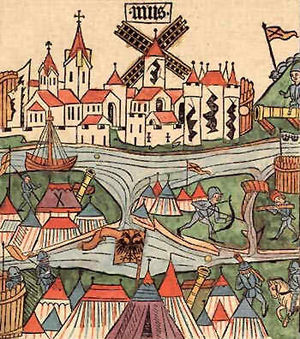Siege of Neuss
| Siege of Neuss | |||||||
|---|---|---|---|---|---|---|---|
| Part of the Burgundian Wars | |||||||
 The Siege of Neuss, from Geschichte Peter Hagenbachs und der Burgunderkriege (1477) by Konrad Pfettisheim |
|||||||
|
|||||||
| Belligerents | |||||||
|
|
|
||||||
| Commanders and leaders | |||||||
|
Duke of Burgundy Elector Palatine Duke of Jülich-Berg |
Administrator of Cologne Holy Roman Emperor |
||||||
| a: Cologne had been effectively independent of the Archbishopric-Electorate since the Battle of Worringen in 1288, but did not become de jure independent until granted Imperial immediacy in the aftermath of this siege. | |||||||
The Siege of Neuss, from 1474–75, was linked to the Cologne Diocesan Feud and part of the Burgundian Wars. The siege, led by Charles the Bold against the Imperial City of Neuss, was unsuccessful. Charles was compelled by the approach of a powerful Imperial army to raise the siege.
Under Charles's father, Philip the Good, the Duchy of Burgundy had allied itself to the cause of the newly elected Archbishop of Cologne, Ruprecht. Ruprecht proved immensely unpopular, and by 1471 several major towns in the archbishopric, as well as the Kölners themselves, were on the verge of revolt. Attempts by the Emperor Frederick III to mediate the conflict failed, and in 1474 Charles the Bold signed a treaty with Ruprecht which stipulated that Charles would subdue the rebels and serve as Ruprecht's lifelong protector in return for 200,000 florins a year. To secure his western border, Charles concluded a treaty with Louis XI of France and then prepared to march into the Rhine valley; contemporaries suspected his real motive was the eventual reconquest of all of Alsace.
Charles's route towards Cologne led him past Neuss, one of the centers of resistance against Ruprecht. Fearing the threat Neuss would pose to his exposed rear if left uninvested, Charles prepared to lay siege to the city, and the investment began on 29 July 1474. The Neussers, though they had had only a short time to prepare, laid in enough provisions to last until Christmas. They were led by Hermann, Landgrave of Hesse, and had the support of many nearby towns and cities.
Charles's army set up siege lines to the North and West of the city; the South and East were guarded by the rivers Krur and Rhine, respectively. Two large islands lay in the Rhine, however, and Charles decided to capture them, reasoning that he would then control passage along the Rhine (and thus prevent the city from being resupplied) and the water supply to the city's moat. Several assaults in early and mid-August eventually captured the islands, though with heavy losses; soon thereafter a bridge to one of the islands collapsed, drowning many of Charles's Italian soldiers. The Burgundians were also harried by hostile peasants.
...
Wikipedia
